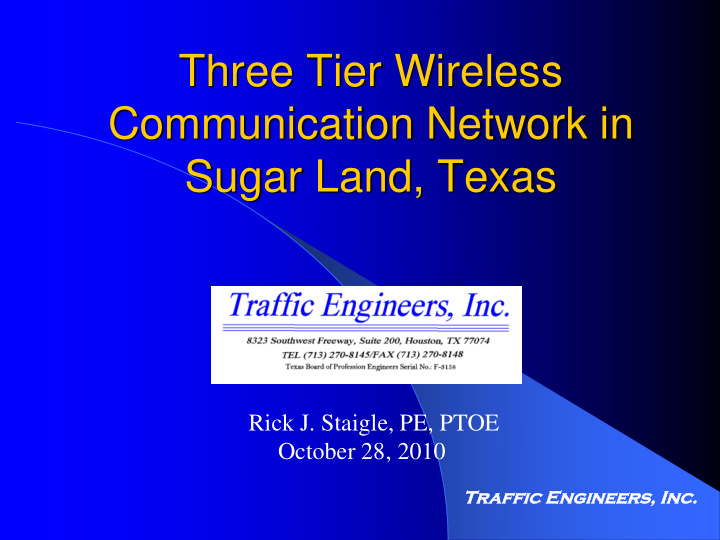



Three Tier Wireless Communication Network in Sugar Land, Texas Rick J. Staigle, PE, PTOE October 28, 2010 Traffic ffic Engi gineer neers, , Inc nc.
Sugar Land, Texas Located in Fort Bend County approximately 20 miles southwest of downtown Houston. One of the fastest growing cities in Texas – #1 in growth in the Houston metro area – #1 among the state's 45 largest cities. – Estimated January 2010 population was 84,511. – City limits encompass approximately 34 square miles, with approximately 21 square miles in its extra-territorial jurisdiction.
Sugar Land, Texas Operates and maintains 72 traffic signals divided into eleven different signal subsystems. Approximately 20 more traffic signals are currently operated by other agencies in the extraterritorial jurisdiction (ETJ) which will become the responsibility of Sugar Land when the areas are annexed over the next ten years.
Sugar Land, Texas Traffic Management Center (TMC) is located at the Public Works building The TMC monitors the eleven signal subsystems through ISDN lines The subsystems use – Spread spectrum radios – Twisted pair copper – Fiber optic cable.
Sugar Land, Texas The TMC utilizes software named ATMS.now (Advanced Traffic Management Systems) to monitor and control the traffic signals. The software and the traffic signal controllers in Sugar Land are produced by Naztec, Inc. Currently communicate at baud rates of up to 19.2 Kbs.
Sugar Land, Texas Sugar Land has a history of installing forward looking ITS projects Recently completed: – Quiet zones and wayside horns were installed for the rail line along the US 90A corridor – Triple-left turn on the US 59 southbound frontage road to eastbound SH 6 which utilizes in-pavement markers and a dynamic message sign
Project Introduction Update all signal controllers to TS2 Ethernet controllers Upgrade to provide communications in the 10 to 1,000 Mbs range. Add additional CCTV cameras Add wireless access points at selected locations Provide wireless communication back to Traffic Management Center
Project Introduction Evaluated communication networks and current technology capable of providing a comprehensive, citywide system solution with sufficient bandwidth and sustainability to provide communication to all existing and proposed traffic signals and CCTV cameras in the City of Sugar Land.
Project Introduction The primary communication mediums investigated were: Fiber optic cable Wi-Fi (2.4 GHz, 4.9 GHz, 5.8 GHz) Wi-MAX Spread Spectrum Communication cable – Hardwire ethernet – Twisted copper pair
Project Introduction Selected Technology: – Short Term - 5.8 GHz frequency – Ultimate - Fiber optic cable Next Step: – Prepare PS&E design to be let through the Texas Department of Transportation
A New Direction IT Department gets involved IT has a parallel project to provide communication for other departments IT is charged with making sure projects are compatible Projects are merged to provide one project with sufficient bandwidth for all departments
Project Redefined Evaluated communication networks and current technology capable of providing a comprehensive, citywide system solution with sufficient bandwidth and sustainability to provide communication to all existing and proposed traffic signals and CCTV cameras in the City of Sugar Land as well as provide sufficient bandwidth for use of other departments.
Project Redefined Traffic Engineers, Inc. was Prime consultant for project – TxDOT Precertifications – TxDOT PS&E experience Civitium, LLP was sub-consultant for high sites and back office design
System Design Wireless backbone was designed using eight high sites – Water towers – Existing buildings – One new self-supporting tower The wireless backbone will use 11 GHz microwave point-to-point radios The wireless backbone will tie to the existing city network at City Hall and Fire Station #2 via fiber optic connections
System Design High sites communicate with traffic signals using 4.9 GHz point-to-multipoint radios Approximately half will include CCTV cameras and Wireless Access Points (WAP) CCTV cameras use HD-264 encryption The WAP, operating at 2.4 GHz, will allow staff to log into the city network from the field The remaining intersections will have some combination of signal controller communication and possibly CCTV cameras
System Design 9 upgrades from TS1 to TS2 Ethernet controllers 35 TS2 signal controllers are having the faceplates replaced to make them Ethernet controllers Approximately half the cabinets had existing Ethernet switches and the rest will have switches installed as part of this project
System Design One intersection exceeded the distance limitations for the Ethernet cable and will utilize multimode fiber for communication between the CCTV cameras and the switch and from the switch to the 4.9 GHz radio Two locations had cameras located away from the intersection and will connect the cameras directly to the 4.9 GHz radio to communicate directly to the high site
Funding and Implementation The project was funded through an Advance Funding Agreement (AFA) between the City of Sugar Land and TxDOT Congestion Mitigation Air Quality funds. The AFA provided for $1.9 million for construction – 80% federal – 20% local match
Funding and Implementation The cost estimate was approximately $1.9 million Four bids were received on the project – Low bid: $1,596,099 – High Bid: $2,748,650. The project is currently under construction and is expected to be completed in fall 2010.
Current Status Eight High Sites are functioning One new High Site being added Half of intersections have been upgraded and are being commissioned by IT department. Working through some issues – Delay in establishing 9 th High Site – Graphical Interface for High Sites not functioning – Video Software accessing cameras in Motion JPEG instead of HD-264, increasing bandwidth usage.
Current Status
Conclusion Traffic and IT don’t always speak the same language The more time you spend working things out make the overall process smoother Low bid projects give a level of uncertainty and sometimes a leap of faith Specifications aren’t always as black and white as you thought they were Combined Traffic/IT project provided a more robust and integrated solution
Recommend
More recommend